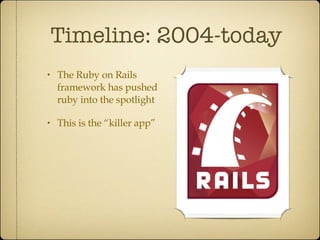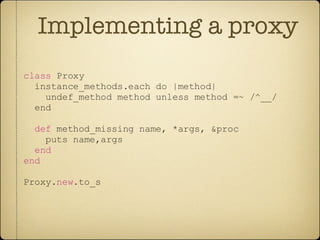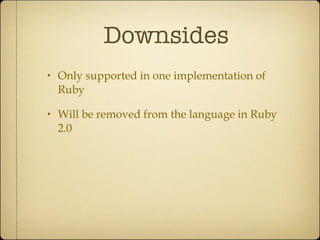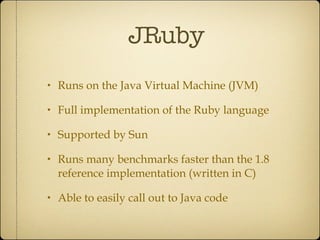Ruby For Java Programmers
- 1. Ruby for Java Programmers Mike Bowler President, Gargoyle Software Inc.
- 2. Why learn another language?
- 3. Why Ruby?
- 4. Timeline: 1993 to 2000 Created in 1993 by Yukihiro "Matz" Matsumoto Ruby was popular in Japan but unknown everywhere else All documentation was written in Japanese
- 5. Timeline: 2000-2004 First English language book published in 2000 A lot of interest in the Agile development community but mostly unknown elsewhere
- 6. Timeline: 2004-today The Ruby on Rails framework has pushed ruby into the spotlight This is the “killer app”
- 8. Terminology Early Late Static Dynamic Strong Weak
- 9. Defining strong/weak typing Strong typing Objects are of a specific type and will not be converted automatically Java: “4”/2 results in a compile error Weak typing Objects can be converted under the covers at any time Perl: ‘4’/2 => 2 Ruby is strongly typed
- 10. Early/late binding Early binding (aka static binding) All method invocations must be defined at compile time Java: foo.getUser() Late binding (aka dynamic binding) The runtime does not check that a given method exists until an attempt to invoke it Smalltalk: foo user. Ruby uses late binding
- 11. Similarities Like Java, Ruby... runs on a virtual machine is garbage collected is object oriented (although to different degrees)
- 12. Differences Everything is an object Java string = String.valueOf(1); Ruby string = 1.to_s() Primitive Object
- 13. Differences Many things that you would expect to be keywords are actually methods throw new IllegalArgumentException( "oops" ); raise TypeError.new( "oops" ) Keywords Methods
- 14. Differences Some syntax optional unless the result is ambiguous These statements are equivalent puts( "foo" ); puts "foo" Idiomatic (better) style
- 15. Differences Classes are real objects They’re instances of Class Class methods can be overridden
- 16. class ZebraCage < Cage attr_accessor :capacity @@allCages = Array. new def initialize maximumZebraCount @capacity = maximumZebraCount @@allCages << self end private def clean_cage # do some stuff here end end cage = ZebraCage. new 10 puts cage.capacity
- 17. Multiline if if name. nil ? do_something end
- 18. Multiline if if name. nil ? do_something end Notice the question mark
- 19. With an else if name. nil ? do_something else something_else end
- 20. Single line if if name. nil ? do_something end do_something if name. nil ?
- 21. Both kinds of unless if name. nil ? do_something end do_something if name. nil ? unless name. nil ? do_something end do_something unless name. nil ?
- 22. Dangerous methods name = " foo " name.strip name.strip! Returns a new string. Doesn’t modify name. Modifies name and returns that. Dangerous!
- 23. Philosophy Java focuses on building blocks You can build whatever you want with the pieces Ruby focuses on solving problems Things you do frequently should be concise
- 24. Initializing arrays List<String> list = new ArrayList<String>(); list.add( "foo" ); list.add( "bar" );
- 25. Same only ruby List<String> list = new ArrayList<String>(); list.add( "foo" ); list.add( "bar" ); list = Array.new list << 'foo' list << 'bar'
- 26. [] List<String> list = new ArrayList<String>(); list.add( "foo" ); list.add( "bar" ); list = Array.new list << 'foo' list << 'bar' list = [ 'foo' , 'bar' ]
- 27. %w() List<String> list = new ArrayList<String>(); list.add( "foo" ); list.add( "bar" ); list = Array.new list << 'foo' list << 'bar' list = [ 'foo' , 'bar' ] list = %w(foo bar)
- 28. In fairness to java... List<String> list = new ArrayList<String>(); list.add( "foo" ); list.add( "bar" ); List<String> list = Arrays.asList( "foo" , "bar" ); list = Array.new list << 'foo' list << 'bar' list = [ 'foo' , 'bar' ] list = %w(foo bar)
- 29. Same idea with hashes Map<String,String> map = new HashMap<String,String>(); map.put( "foo" , "one" ); map.put( "bar" , "two" ); map = { 'foo' => 'one' , 'bar' => 'two' }
- 30. Special case for Hash hash = { :a => 5 , :b => 3 } do_stuff 30 , hash do_stuff 100 , :a => 5 , :b => 3
- 31. Regular Expressions Pattern pattern = Pattern.compile( "^\\s*(.+)\\s*$" ); Matcher matcher = pattern .matcher(line); if ( matcher.matches() ) { doSomething(); }
- 32. Regular Expressions Pattern pattern = Pattern.compile( "^\\s*(.+)\\s*$" ); Matcher matcher = pattern .matcher(line); if ( matcher.matches() ) { doSomething(); } do_something if line =~ /^\s*(.+)\s*$/
- 33. Nil and Null Java’s null Ruby’s nil Absence of an object An instance of NilClass if( a != null ) {...} unless a.nil? {...} null.toString() -> NPE nil.to_s -> “” null.getUser() -> Exception in thread "main" java.lang.NullPointerException nil.get_user -> NoMethodError: undefined method ‘get_user’ for nil:NilClass
- 34. Implications of late binding Method dispatch is quite different Ruby makes a distinction between “messages” that are sent to an object and the “methods” that get dispatched
- 36. What if there isn’t a method for the specified message?
- 37. method_missing example from ActiveRecord user = Users.find_by_name(name) user = Users.find( :first , :conditions => [ "name = ?" , name])
- 38. Creating proxy objects Mock object for testing Proxy object to allow distributed objects across machines Wrapper to record usage of a given object
- 39. Implementing a proxy class Proxy def method_missing name, *args, &proc puts name,args end end
- 40. Implementing a proxy class Proxy def method_missing name, *args, &proc puts name,args end end Proxy. new .foo_bar ‘a’ Proxy. new .to_s Dispatches to method_missing Doesn’t go to method_missing
- 41. Overriding to_s class Proxy def method_missing name, *args, &proc puts name,args end def to_s method_missing :to_s, [] end end
- 42. = • === • =~ • __id__ • _send__ • class • clone • dclone display • dup • enum_for • eql? • equal? • extend freeze frozen? • hash • id • inspect • instance_eval instance_of? instance_variable_defined • instance_variable_get instance_variable_get • instance_variable_set instance_variable_set • instance_variables • is_a? kind_of? • method • methods • new • nil? • object_id p rivate_methods • protected_methods • public_methods remove_instance_variable • respond_to? • send singleton_method_added • singleton_method_removed singleton_method_undefined • singleton_methods • taint tainted? • to_a • to_enum • to_s • to_yaml to_yaml_properties • to_yaml_style • type • untaint
- 43. Implementing a proxy class Proxy instance_methods.each do |method| undef_method method unless method =~ /^__/ end def method_missing name, *args, &proc puts name,args end end Proxy. new .to_s
- 44. Unix was not designed to stop people from doing stupid things, because that would also stop them from doing clever things. — Doug Gwyn
- 45. Cultural differences about type Java is very focused on the types of objects Is the object an instance of a specific class? Or does it implement a specific interface? Ruby is focused on the behaviour Does the object respond to a given message?
- 46. Types public void foo( ArrayList list ) { list.add( "foo" ); } def foo list list << 'foo' end What’s the type? What’s the type?
- 47. Duck typing def foo list list << 'foo' end If list is a String => ‘foo’ If list is an Array => [‘foo’] If list is an IO => string will be written to stream
- 48. Duck typing Duck typing implies that an object is interchangeable with any other object that implements the same interface, regardless of whether the objects have a related inheritance hierarchy. -- Wikipedia "If it walks like a duck and quacks like a duck, it must be a duck." -- Pragmatic Dave Thomas
- 49. How does this change how we think of types? think of types? think of types?
- 50. Overflow conditions int a = Integer. MAX_VALUE ; System. out .println( " a=" +a); System. out .println( "a+1=" +(a+1)); a=2147483647 a+1= ??
- 51. Overflow conditions int a = Integer. MAX_VALUE ; System. out .println( " a=" +a); System. out .println( "a+1=" +(a+1)); a=2147483647 a+1=-2147483648 oops
- 52. Overflow in ruby? number = 1000 1 .upto( 4 ) do puts "#{number.class} #{number}" number = number * number end Fixnum 1000 Fixnum 1000000 Bignum 1000000000000 Bignum 1000000000000000000000000
- 53. Closures A closure is a function that is evaluated in an environment containing one or more bound variables. When called, the function can access these variables. The explicit use of closures is associated with functional programming and with languages such as ML and Lisp. Constructs such as objects in other languages can also be modeled with closures. -- Wikipedia
- 54. Closures A closure is a block of code that you can manipulate and query In Ruby we call them blocks or Procs A block is a pure closure A Proc is a block wrapped as an object We generally use the terms block and Proc interchangeably
- 55. Closures multiplier = 5 block = lambda {|number| puts number * multiplier } A block An instance of Proc lambda() is a method to convert blocks into Procs
- 56. Closures multiplier = 5 block = lambda {|number| puts number * multiplier } Parameter to the block
- 57. Closures multiplier = 5 block = lambda {|number| puts number * multiplier } Able to access variables from outside the block
- 58. Proc’s multiplier = 5 block = lambda {|number| puts number * multiplier } block.call 2 block.arity prints 10 returns number of parameters that the block takes. 1 in this case
- 59. Blocks as parameters multiplier = 5 1.upto(3) {|number| puts number * multiplier } => 5 => 10 => 15 Same block as before Called once for each time through the loop
- 60. Alternate syntax multiplier = 5 1.upto(3) {|number| puts number * multiplier } 1.upto(3) do |number| puts number * multiplier end Equivalent
- 61. Why are closures significant? Presence of closures in a language completely changes the design of the libraries Closure based libraries generally result in significantly less code
- 62. // Read the lines and split them into columns List<String[]> lines= new ArrayList<String[]>(); BufferedReader reader = null ; try { reader = new BufferedReader( new FileReader( "people.txt" )); String line = reader.readLine(); while ( line != null ) { lines.add( line.split( "\t" ) ); } } finally { if ( reader != null ) { reader.close(); } } // then sort Collections.sort(lines, new Comparator<String[]>() { public int compare(String[] one, String[] two) { return one[1].compareTo(two[1]); } }); // then write them back out BufferedWriter writer = null ; try { writer = new BufferedWriter( new FileWriter( "people.txt" ) ); for ( String[] strings : lines ) { StringBuilder builder = new StringBuilder(); for ( int i=0; i<strings. length ; i++ ) { if ( i != 0 ) { builder.append( "\t" ); } builder.append(strings[i]); } } } finally { if ( writer != null ) { writer.close(); } } # Load the data lines = Array. new IO.foreach( 'people.txt' ) do |line| lines << line.split end # Sort and write it back out File.open( 'people.txt' , 'w' ) do |file| lines.sort {|a,b| a[ 1 ] <=> b[ 1 ]}. each do |array| puts array.join( "\t" ) end end
- 63. Closure File Example file = File. new (fileName, 'w' ) begin file.puts ‘some content’ rescue file.close end
- 64. Closure File Example file = File. new (fileName, 'w' ) begin file.puts ‘some content’ rescue file.close end Only one line of business logic
- 65. Closure File Example file = File. new (fileName, 'w' ) begin file.puts ‘some content’ rescue file.close end File.open(fileName, 'w' ) do |file| file.puts ‘some content’ end
- 66. Ruby file IO sample # Load the data lines = Array. new IO.foreach( 'people.txt' ) do |line| lines << line.split end # Sort and write it back out File.open( 'people.txt' , 'w' ) do |file| lines.sort {|a,b| a[ 1 ] <=> b[ 1 ]}. each do |array| puts array.join( "\t" ) end end
- 67. Closure-like things in Java final String name = getName(); new Thread( new Runnable() { public void run() { doSomething(name); } }).start(); Only one line of business logic
- 68. Closures for Java? There are a couple of proposals being debated for Java7 Unclear whether any of them will be accepted In the past, Sun’s position has been that closures didn’t make sense at this point in Java’s evolution public static void main(String[] args) { int plus2(int x) { return x+2; } int(int) plus2b = plus2; System.out.println(plus2b(2)); }
- 69. Inheriting behaviour from multiple places C++ has multiple inheritance Java has interfaces Ruby has mixins
- 70. C++ : multiple inheritance
- 72. Ruby : mixins
- 73. Mixins Cannot be instantiated Can be mixed in
- 74. Enumerable class Foo include Enumerable def each &block block.call 1 block.call 2 block.call 3 end end module Enumerable def collect array = [] each do |a| array << yield (a) end array end end
- 75. Enumerable class Foo include Enumerable def each &block block.call 1 block.call 2 block.call 3 end end module Enumerable def collect array = [] each do |a| array << yield (a) end array end end
- 76. Enumerable Requires that the class implement each() For max, min and sort the <=> operator is also needed Adds many methods for modifying, searching, sorting the items all?, any?, collect, detect, each_cons, each_slice, each_with_index, entries, enum_cons, enum_slice, enum_with_index, find, find_all, grep, include?, inject, map, max, member?, min, partition, reject, select, sort, sort_by, to_a, to_set, zip
- 77. Reopening classes class Foo def one puts 'one' end end
- 78. Reopening classes class Foo def one puts 'one' end end class Foo def two puts 'two' end end Reopening the same class
- 79. Reopening classes class Foo def one puts 'one' end end class Foo def one puts '1' end end Replacing, not adding a method
- 80. Reopening core classes class String def one puts 'one' end end We reopened a CORE class and modified it
- 81. Metaprogramming Metaprogramming is the writing of computer programs that write or manipulate other programs (or themselves) as their data. In many cases, this allows programmers to get more done in the same amount of time as they would take to write all the code manually. -- Wikipedia
- 82. What changes can we make at runtime? Anything we can hand code, we can programmatically do Because of late binding, EVERYTHING happens at runtime
- 83. attr_accessor class Foo attr_accessor :bar end class Foo def bar @bar end def bar=(newBar) @bar = newBar end end Getter Setter
- 84. Possible implementation of attr_accessor class Foo def self.attr_accessor name module_eval <<-DONE def #{name}() @ #{name} end def #{name}=(newValue) @ #{name} = newValue end DONE end my_attr_accessor :bar end
- 85. Possible implementation of attr_accessor class Foo def self.attr_accessor name module_eval <<-DONE def #{name}() @ #{name} end def #{name}=(newValue) @ #{name} = newValue end DONE end my_attr_accessor :bar end “ Here Doc” Evaluates to String
- 86. Possible implementation of attr_accessor class Foo def self.attr_accessor name module_eval <<-DONE def #{name}() @ #{name} end def #{name}=(newValue) @ #{name} = newValue end DONE end my_attr_accessor :bar end String substitution
- 87. Possible implementation of attr_accessor class Foo def self.attr_accessor name module_eval <<-DONE def #{name}() @ #{name} end def #{name}=(newValue) @ #{name} = newValue end DONE end my_attr_accessor :bar end Executes the string in the context of the class
- 88. Result class Foo def bar @bar end def bar=(newBar) @bar = newBar end end
- 89. ActiveRecord class ListItem < ActiveRecord::Base belongs_to :amazon_item acts_as_taggable acts_as_list :scope => :user end
- 90. Date :: once def once(*ids) # :nodoc: for id in ids module_eval <<-" end ;", __FILE__, __LINE__ alias_method :__ #{id.to_i}__, :#{id.to_s} private :__ #{id.to_i}__ def #{id.to_s}(*args, &block) if defined? @__ #{id.to_i}__ @__ #{id.to_i}__ elsif ! self.frozen? @__ #{id.to_i}__ ||= __#{id.to_i}__(*args, &block) else __ #{id.to_i}__(*args, &block) end end end ; end end
- 91. ObjectSpace ObjectSpace.each_object do |o| puts o end ObjectSpace.each_object(String) do |o| puts o end
- 92. ObjectSpace ObjectSpace.each_object do |o| puts o end ObjectSpace.each_object(String) do |o| puts o end All objects Only Strings
- 93. Continuations A snapshot of the call stack that the application can revert to at some point in the future
- 94. Why continuations? To save the state of the application across reboots of the VM To save the state of the application across requests to a web server Seaside (smalltalk) does this today
- 95. Downsides Only supported in one implementation of Ruby Will be removed from the language in Ruby 2.0
- 96. Implementations Ruby 1.8.x - “reference implementation” in C Ruby 1.9 - Next version of C interpreter Rubinius - Ruby in Ruby (sort-of) Cardinal - Ruby on Parrot Iron Ruby - Ruby on the DLR (Microsoft) Ruby.NET - Ruby on the CLR JRuby - Ruby on the JVM (Sun)
- 97. Implementations Ruby 1.8.x - “reference implementation” in C Ruby 1.9 - Next version of C interpreter Rubinius - Ruby in Ruby (sort-of) Cardinal - Ruby on Parrot Iron Ruby - Ruby on the DLR (Microsoft) Ruby.NET - Ruby on the CLR JRuby - Ruby on the JVM (Sun)
- 98. JRuby Runs on the Java Virtual Machine (JVM) Full implementation of the Ruby language Supported by Sun Runs many benchmarks faster than the 1.8 reference implementation (written in C) Able to easily call out to Java code
- 99. Ruby on Rails Web application framework Sweet spot - web application talking to a single relational database Allows very rapid development of web apps
- 100. Who’s using rails? Amazon • BBC • Cap Gemini Chicago Tribune • Barclays • BPN • Cisco CNET Electronic Arts • IBM • John Deere JP Morgan Chase • LA Times • Limewire Linked In • NASA • NBC • New York Times Oakley • Oracle • Orbitz • Turner Media twitter.com • Siemens • ThoughtWorks Yahoo!
- 101. JRuby on Rails? Yes! You can run a rails application on JRuby in a servlet container Goldspike is the servlet that dispatches to rails Tested on WebLogic, WebSphere, GlassFish, Jetty, Tomcat Warbler is the packaging tool that makes the WAR Supported on: WebLogic, WebSphere, GlassFish, Jetty, Tomcat
- 102. Recap Learning a new language will make you better with all the languages you know Ruby has a much more concise syntax which means that it takes much less code to solve the same problems Ruby is able to run on the JVM which makes it an option for shops with heavy investments in J2EE infrastructure
- 103. Recap Everything is an object The language is extremely malleable New classes/methods can be created on the fly Existing classes can be modified at any time
- 104. Contacting me Mike Bowler [email_address] www.GargoyleSoftware.com (co mpany) www.SphericalImpr ovement.com (blog) Interested in le arning more about how Ruby a nd Java can coexist in your company? Just ask me.


























![[] List<String> list = new ArrayList<String>(); list.add( "foo" ); list.add( "bar" ); list = Array.new list << 'foo' list << 'bar' list = [ 'foo' , 'bar' ]](https://image.slidesharecdn.com/rubyforjavaprogrammers-1210167973516759-9/85/Ruby-For-Java-Programmers-26-320.jpg)
![%w() List<String> list = new ArrayList<String>(); list.add( "foo" ); list.add( "bar" ); list = Array.new list << 'foo' list << 'bar' list = [ 'foo' , 'bar' ] list = %w(foo bar)](https://image.slidesharecdn.com/rubyforjavaprogrammers-1210167973516759-9/85/Ruby-For-Java-Programmers-27-320.jpg)
![In fairness to java... List<String> list = new ArrayList<String>(); list.add( "foo" ); list.add( "bar" ); List<String> list = Arrays.asList( "foo" , "bar" ); list = Array.new list << 'foo' list << 'bar' list = [ 'foo' , 'bar' ] list = %w(foo bar)](https://image.slidesharecdn.com/rubyforjavaprogrammers-1210167973516759-9/85/Ruby-For-Java-Programmers-28-320.jpg)








![method_missing example from ActiveRecord user = Users.find_by_name(name) user = Users.find( :first , :conditions => [ "name = ?" , name])](https://image.slidesharecdn.com/rubyforjavaprogrammers-1210167973516759-9/85/Ruby-For-Java-Programmers-37-320.jpg)



![Overriding to_s class Proxy def method_missing name, *args, &proc puts name,args end def to_s method_missing :to_s, [] end end](https://image.slidesharecdn.com/rubyforjavaprogrammers-1210167973516759-9/85/Ruby-For-Java-Programmers-41-320.jpg)





![Duck typing def foo list list << 'foo' end If list is a String => ‘foo’ If list is an Array => [‘foo’] If list is an IO => string will be written to stream](https://image.slidesharecdn.com/rubyforjavaprogrammers-1210167973516759-9/85/Ruby-For-Java-Programmers-47-320.jpg)














![// Read the lines and split them into columns List<String[]> lines= new ArrayList<String[]>(); BufferedReader reader = null ; try { reader = new BufferedReader( new FileReader( "people.txt" )); String line = reader.readLine(); while ( line != null ) { lines.add( line.split( "\t" ) ); } } finally { if ( reader != null ) { reader.close(); } } // then sort Collections.sort(lines, new Comparator<String[]>() { public int compare(String[] one, String[] two) { return one[1].compareTo(two[1]); } }); // then write them back out BufferedWriter writer = null ; try { writer = new BufferedWriter( new FileWriter( "people.txt" ) ); for ( String[] strings : lines ) { StringBuilder builder = new StringBuilder(); for ( int i=0; i<strings. length ; i++ ) { if ( i != 0 ) { builder.append( "\t" ); } builder.append(strings[i]); } } } finally { if ( writer != null ) { writer.close(); } } # Load the data lines = Array. new IO.foreach( 'people.txt' ) do |line| lines << line.split end # Sort and write it back out File.open( 'people.txt' , 'w' ) do |file| lines.sort {|a,b| a[ 1 ] <=> b[ 1 ]}. each do |array| puts array.join( "\t" ) end end](https://image.slidesharecdn.com/rubyforjavaprogrammers-1210167973516759-9/85/Ruby-For-Java-Programmers-62-320.jpg)



![Ruby file IO sample # Load the data lines = Array. new IO.foreach( 'people.txt' ) do |line| lines << line.split end # Sort and write it back out File.open( 'people.txt' , 'w' ) do |file| lines.sort {|a,b| a[ 1 ] <=> b[ 1 ]}. each do |array| puts array.join( "\t" ) end end](https://image.slidesharecdn.com/rubyforjavaprogrammers-1210167973516759-9/85/Ruby-For-Java-Programmers-66-320.jpg)

![Closures for Java? There are a couple of proposals being debated for Java7 Unclear whether any of them will be accepted In the past, Sun’s position has been that closures didn’t make sense at this point in Java’s evolution public static void main(String[] args) { int plus2(int x) { return x+2; } int(int) plus2b = plus2; System.out.println(plus2b(2)); }](https://image.slidesharecdn.com/rubyforjavaprogrammers-1210167973516759-9/85/Ruby-For-Java-Programmers-68-320.jpg)





![Enumerable class Foo include Enumerable def each &block block.call 1 block.call 2 block.call 3 end end module Enumerable def collect array = [] each do |a| array << yield (a) end array end end](https://image.slidesharecdn.com/rubyforjavaprogrammers-1210167973516759-9/85/Ruby-For-Java-Programmers-74-320.jpg)
![Enumerable class Foo include Enumerable def each &block block.call 1 block.call 2 block.call 3 end end module Enumerable def collect array = [] each do |a| array << yield (a) end array end end](https://image.slidesharecdn.com/rubyforjavaprogrammers-1210167973516759-9/85/Ruby-For-Java-Programmers-75-320.jpg)




























![Contacting me Mike Bowler [email_address] www.GargoyleSoftware.com (co mpany) www.SphericalImpr ovement.com (blog) Interested in le arning more about how Ruby a nd Java can coexist in your company? Just ask me.](https://image.slidesharecdn.com/rubyforjavaprogrammers-1210167973516759-9/85/Ruby-For-Java-Programmers-104-320.jpg)



































![QA Automation Battle: Java vs Python vs Ruby [09.04.2015]](https://cdn.slidesharecdn.com/ss_thumbnails/automation-final-150409112409-conversion-gate01-thumbnail.jpg?width=560&fit=bounds)




















































